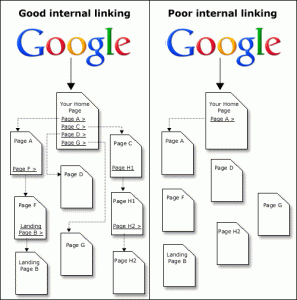 Internal linking can be just as valuable as inbound links if you have high-value pages on your website. Yet, so many SEOs ignore or undervalue the power of internal links. Another important use of these types of links is for promoting link equity across the site. How? You can use it to channel link juice to other low volume pages and to make it easy for users and search engines to discover these pages.
Internal linking can be just as valuable as inbound links if you have high-value pages on your website. Yet, so many SEOs ignore or undervalue the power of internal links. Another important use of these types of links is for promoting link equity across the site. How? You can use it to channel link juice to other low volume pages and to make it easy for users and search engines to discover these pages.
An internal link strategy should then be an essential part of your site’s SEO. Below you will find 7 ways to boost your internal link structure.
1. Tap Into The Power of High Profile Pages
Use a tool like Open Site Explorer to find the pages on your site that are most linked to. Add internal links on those pages to pages that you will like to increase traffic to. By doing this you will not only transfer traffic but link juice as well.
2. Interlink Your SEO Landing Pages
Scale your internal link building efforts by interlinking all your SEO landing pages so that link equity is transferred between pages. This can be done quickly and easily if your site is built on the WordPress platform by using a related post plugin. This plugin adds related posts at the end of each page.
3. Don’t Overlook Your Home Page
Since most external links to a website usually go to the homepage it is very important to send some of that link juice from your homepage to other pages on the site. The fact that the authority page on your site is linking to other pages improves the perceived quality of the pages that you are linking to. If you’re concerned about taking up valuable space on your prime page you can always place the links below the fold.
4. Post Links From Not So Obvious Pages
Contact, About, Disclaimer and Privacy pages are pages where you can drop internal links. These are great pages to build your internal link structure since they seldom have other competing links which is great for passing on link juice.
5. The Website Footer
There are some firmly held beliefs that Google does not place much value on footer links. Of course this can be surmised just based on the position of the links alone. While this might be true for links to external sites when you link to internal pages from the footer some value is transferred.
6. Breadcrumbs
The obvious importance of breadcrumbs is as a navigational tool for taking visitors back to the homepage. The not so obvious value is in the internal linking that it provides. Breadcrumbs provide a value for link equity and anchor text links within the site.
7. Build An Internal Link Dashboard
Keep track of your internal links so that you can easily make revisions to your internal link structure when you need to. Revisions are sometimes necessary when you want to target more revenue producing keywords or adjust your keywords to ones that are bringing in the most traffic. It is also useful when you want to know which pages are already linked up and which ones are not.
Record keeping is very important. Track the dates, stats and outcome of each internal link that you add. To make it easy you can import the data from your Webmaster Tools dashboard. Starting linking up your pages with internal links and see what a difference it makes to the rankings on your site’s internal pages in the SERPs.
